What basic equipment do I need to do dollhouse needlepoint?
ONLINE MINIATURE NEEDLEPOINT EMBROIDERY TUTORIALS
 These tutorials were originally written to help people who had bought my dollhouse needlepoint kits – they show you how to do the stitching and assemble each type of kit. In November 2024 I retired, so these pages are now a ‘legacy archive’ only. I NO LONGER SELL THESE KITS, so please do not contact me asking where you can buy them! I plan to keep these tutorials available until at least the end of 2026, so that people who bought kits but haven’t made them up yet have a while to use the tutorials to complete their kits 🙂
These tutorials were originally written to help people who had bought my dollhouse needlepoint kits – they show you how to do the stitching and assemble each type of kit. In November 2024 I retired, so these pages are now a ‘legacy archive’ only. I NO LONGER SELL THESE KITS, so please do not contact me asking where you can buy them! I plan to keep these tutorials available until at least the end of 2026, so that people who bought kits but haven’t made them up yet have a while to use the tutorials to complete their kits 🙂
The basic equipment that you need is actually not much more than you would normally use for ‘full size’ stitching. Just a few pieces of equipment are really necessary, and you can then go ahead and start making beautiful miniature embroideries right away.
I have listed the essentials first, then the optional extras, below. Even if you have never done any kind of stitching before, the real essentials are few, and they needn’t cost a fortune. They are easily obtainable from craft shops (either bricks and mortar shops, or online ones).
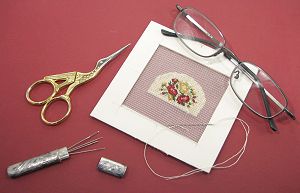
MAGNIFER: Many people think that a magnifier would be an essential piece of equipment if you want to stitch in a small scale. If you feel that your eyesight warrants it, then by all means go ahead and use one, but it isn’t essential unless you are stitching on the tiniest counts of fabric (say, 32 count or finer), in my opinion. As my eyesight has changed over the years, I now find that the glasses that I use for ‘distance’ vision (which were quite a gentle prescription, so that I wore them all the time), now have to be removed when I want to do close work. Even so, for stitching on the finest gauze I only need to use the cheap kind of ‘reading glasses’ available in supermarkets for a couple of pounds. These give magnification of about two and a half times, and are all that is needed to make the fabric and stitches that much sharper – experiment for yourself to work out what magnification you are comfortable using.
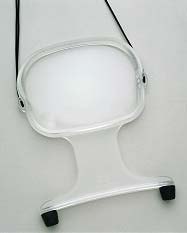
The kind of magnifier that you wear round your neck on a cord, and rest on your chest is a light and comfortable way to magnify your work, too. If you want to go for the ‘bells and whistles’ approach, then combined ‘light and magnifier’ standard lamp systems are available in needlework shops in several ranges and price points.
I found a good tip via an online forum recently about using magnification when doing embroidery. If you are using any kind of magnifier, be it glasses or one attached to a frame or an angle-poise lamp, it is less tiring on your eyes if you try to only focus your eyes on your fabric and your chart, and try not to look away sometimes to objects at a distance as well. Alternating between objects at two different distances causes your eyes to have to work much harder at continually re-adjusting the focus. Obviously, this would make your eyes tire much quicker, so you would have to stop stitching sooner – something to be avoided at all costs!
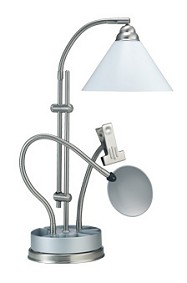
LIGHTING: I think that good lighting is probably more necessary than a magnifier. There is nothing worse than squinting to choose the colours of thread you need next, or worse, using the wrong shade and then having to unpick it. A good daylight bulb in a lamp that can be easily positioned above your working area is a good investment, then.
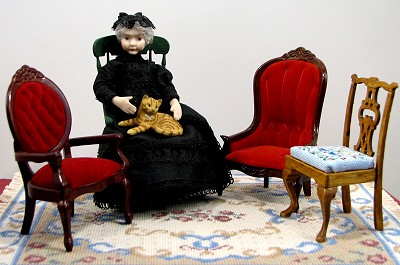
SEATING: A comfortable chair is necessary, so that you don’t ‘hunch up’ over your work, and get a stiff neck in the process. Being comfortable means you can stitch for longer, which is something we’d all like to do, given the opportunity!
Obviously, the chairs shown in this picture are doll’s house scale ones, but they illustrate the kind of chair that is suitable for sitting in whilst stitching. Having a cat on your lap is NOT a good idea, as cats love to eat your thread, and weave fluff into your stitches while you aren’t looking!

SCISSORS: Fine pointed embroidery scissors ( I like using ‘stork’ design scissors) are best for cutting threads cleanly, but you probably already have a pair you are used to using for ‘full-size’ embroidery or cross stitch work – it is not necessary to invest in a pair specially for miniature embroidery. Thread snips are also useful additions to your sewing box. A pair of sharp dressmaking scissors are useful for cutting fabric, too. Just make sure that whatever types you use, they are really sharp!
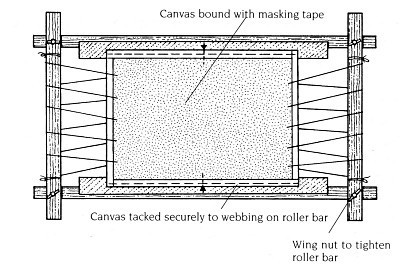
FRAMES: If you do not usually use a frame, I strongly advise you to start now! There is nothing so demoralising as spending hours on a piece of embroidery, with most of it scrunched up in one hand as you work on the exposed corner, only to flatten out the fabric and find that what you have made is a bumpy, misshapen failure. Probably, then, unless your tension is very light and even, a frame of some kind will be necessary. Using a frame need not make embroidery an uncomfortable, unwieldy experience, though. They are not expensive, and if you shop around and get the right sort of frame for you, you will be amazed at the improvement in your work. A rectangular rotating frame is useful for working anything using canvas (such as the carpet or wallhanging kits), if the fabric is larger than about 5 inches square (smaller than that, it can be worked in your hand without a frame, without distorting in the process). The kind of rotating frame I like to use is hand-held and has 24 inch rollers and 12 inch side-bars. There are versions on the market that clamp onto table-tops, while others are floor-standing. The canvas is fixed to the frame by sewing the top and bottom edges to webbing strips on the rollers, and fixed at the sides by lacing with strong thread. It can be time-consuming to set up a piece of canvas on a frame, but it is worth the effort if you are going to spend many hours on a piece of work, as using this kind of frame almost completely eliminates distortion of the canvas.
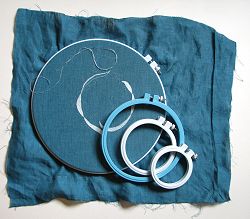
This picture shows various sizes of hoop frame (where two wooden or plastic rings fit one inside the other, and hold the fabric tautly between them). Although this kind of frame is ideal for free-style surface embroidery, it is unsuitable for canvas or silk gauze, as the hoops crush the thick canvas threads, and adequate tension cannot be maintained. So, this picture shows what NOT to use!
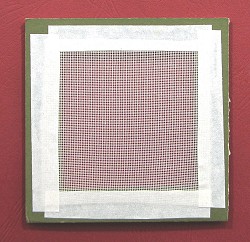
A frame cut from thick mount board with an aperture cut slightly smaller than the fabric piece is what you need when stitching on silk gauze. With a card mount, you simply use masking tape to stick the fabric to the card, so that the fabric is held tautly and the central area is exposed so that stitching is easily accomplished. Where it would be helpful to use a card mount, the relevant size that you need to make it is detailed in the instructions of the kits (such as the bellpulls, for instance).
Some of my kits are worked on small pieces of evenweave fabric (usually 28 or 32 count). This fabric is quite robust, and I find that it does not need a frame of any kind, as it is tightly woven. However, if you like using frames for all your stitching projects, mount evenweave in a card mount as you would silk gauze.
OPTIONAL ITEMS: It is a well-known fact that once you have become absorbed in a hobby, collecting all the equipment is part of the fun. There are many gadgets available for embroiderers, some far more effective than others. Here are a few I would not like to be without.
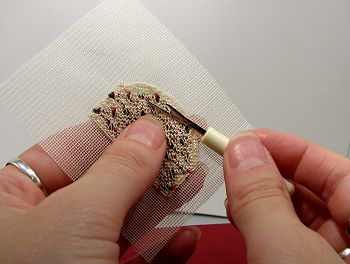
STITCH RIPPER: A stitch ripper is a useful piece of equipment for those depressing times when you realise you have skipped a stitch in your pattern, and have been gaily completing row after row of stitches, all one stitch to the left of where they should have been. A stitch ripper is better than using embroidery scissors to unpick with, as it has a very sharp, curved blade on the lower edge. You can isolate one stitch with it and cleanly slice it from beneath, without the risk of cutting into the fabric as well.
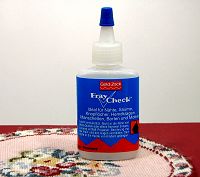
FABRIC GLUE: I feel that a clear fabric glue such as Fray Check is an essential item to have. Fabric glue is a colourless liquid which prevents unravelling when applied to cut fabric edges. It has the advantage over conventional glues that it is totally invisible once dry and will withstand washing. For carpets of an unusual shape, which cannot be hemmed in the usual way, it is invaluable I also recommend it for use with finishing treatments for kits such as the needlework stands.
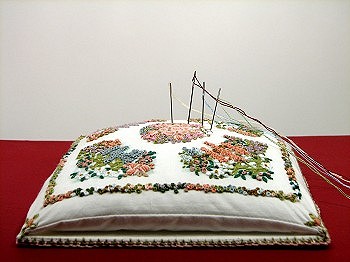
PIN CUSHION: From experience, I can tell you that if you do not invest in a pin cushion to ‘park’ your needles in, then at some point (no pun intended) you are likely to inadvertently sit on your needle! You really need to have a dedicated place to put your needle whilst choosing colours, checking the chart, and so on (note: your mouth is not the ideal place, either!). If you are working a design with many small areas of colour, it can be very time-saving to thread up a separate needle with each colour needed, too.

AND FINALLY: One more thing that you need is enthusiasm for the design you are going to stitch! I find that it is more likely that a project will be finished if you choose a design that really takes your fancy, rather than one which you think ‘will do’ just because it looks easy, or is in the right colours.
10 tips for mini-stitching
- Work in a good light
- Make sure you are sitting comfortably!
- Use the correct size of needle for the thread count of your fabric
- Use a frame if your tension is at all ‘tight’
- Follow the chart carefully
- Keep the back of your work neat
- Use the ‘waste knot’ method when starting a new length
- Use the correct stitch (tent stitch for details, basketweave for backgrounds – do NOT use half cross stitch!)
- Take regular breaks so that you do not get eyestrain
- Enjoy it – the pleasure should be in the making, not just in the finished article.
